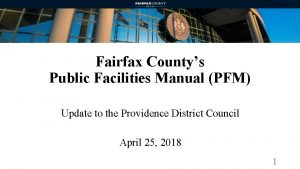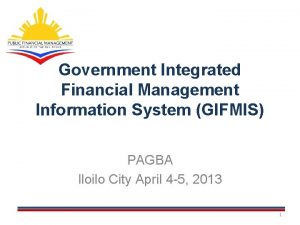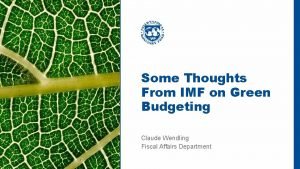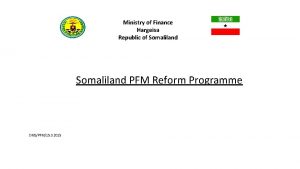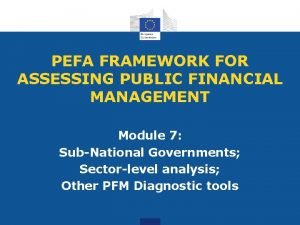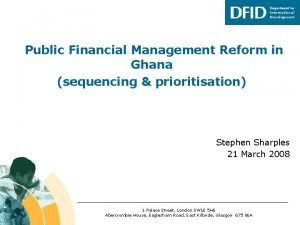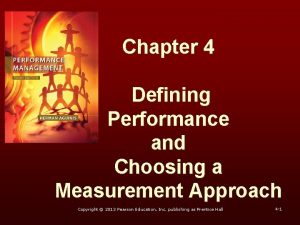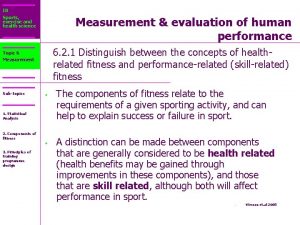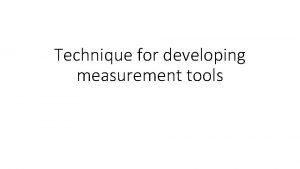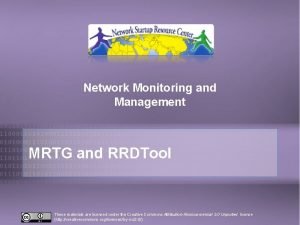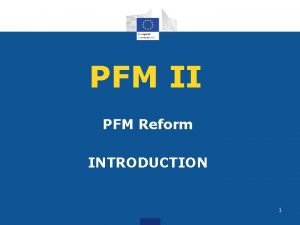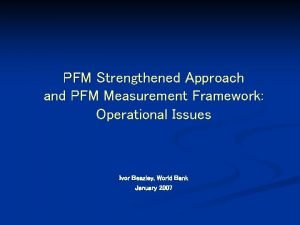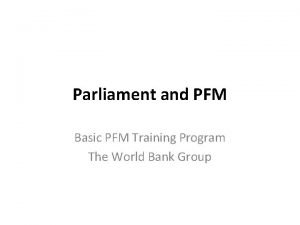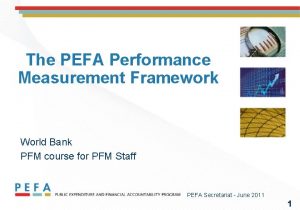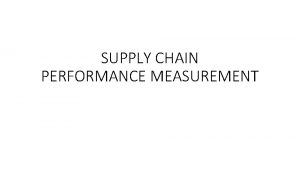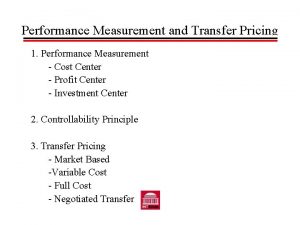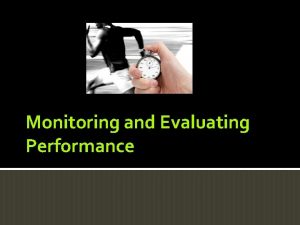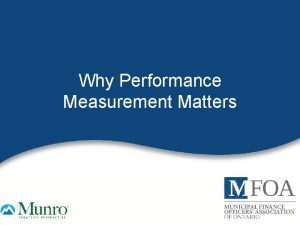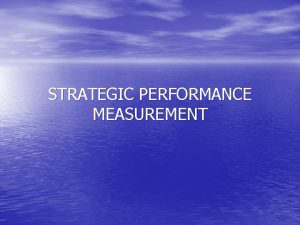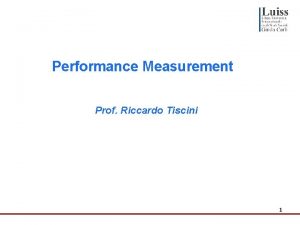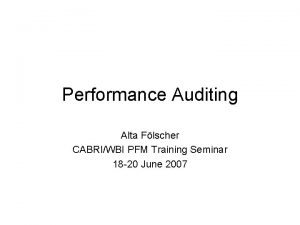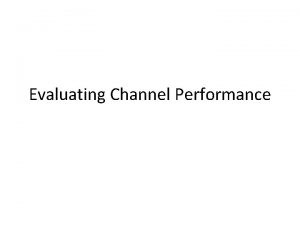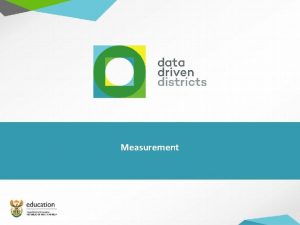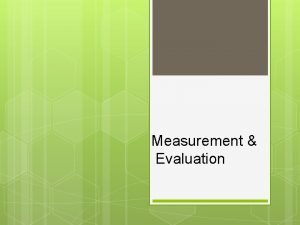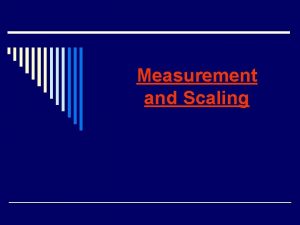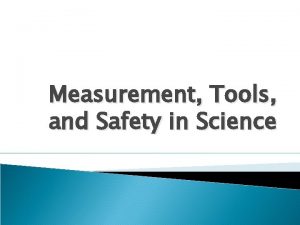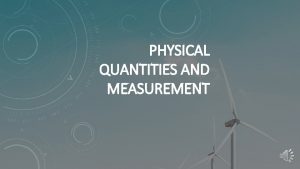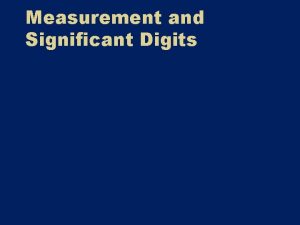A Tool for PFM Performance Measurement and Monitoring
























- Slides: 24

A Tool for PFM Performance Measurement and Monitoring The PFM Performance Measurement Framework Workshop on Applying the PFM Performance Measurement Framework and the Strengthened Approach to Support PFM Reform World Bank, January 17 -18, 2007 Frans Ronsholt PEFA Secretariat Page 1

COMPONENTS OF THE FRAMEWORK • A standard set of high level PFM indicators to assess performance against 6 critical dimensions of a PFM system • 28 government performance indicators • 3 donor indicators, reflecting donor practices influencing the government’s PFM systems • A concise, integrated report – the PFM performance report developed to provide narrative on the indicators and to draw a summary from the analysis Page 2

DIMENSIONS OF PFM SYSTEM PERFORMANCE External scrutiny and audit: Budget credibility: Is the budget realistic, and implemented as intended? Comprehensiveness and transparency : Are the budget and the fiscal risk oversight comprehensive, and is fiscal and budget information accessible to the public? Policy-based budgeting: Is the budget prepared with due regard to government policy? Six critical dimensions of PFM system performance Are there effective arrangements for scrutiny of public finances and follow up by the executive? Accounting, recording and reporting: Are adequate records and information produced, maintained and disseminated to meet decision-making, control, management and reporting purposes? Predictability and control in budget execution: Is the budget implemented in a predictable manner and are control and stewardship exercised in the collection and use of public funds? Page 3

FOCUS OF THE FRAMEWORK • Focused on central government operations • Links to other parts of the public sector • Sub-National Governments • Public Enterprises, to the extent these have implications for Central Government • Can be used for sub-national government, if desired Page 4

The PFM Performance Indicator Set Page 5

PRACTICAL ASPECTS OF THE DESIGN OF THE INDICATORS • High level system performance is measured • does not measure capacity factors • Full overview of the PFM system • revenue, expenditure, procurement, financial assets/ liabilities • Scoring based on extent of ‘Good Practice’ • Basis for design: • 16 HIPC Expenditure Tracking, but broader coverage • draws on IMF’s Fiscal Standards and Codes (ROSC) • internationally accepted standards e. g. GFS, IPSAS, INTOSAI • Widely applicable to countries at all levels of development Page 6

STRUCTURE OF THE PERFORMANCE INDICATOR SET C. Budget Cycle D. Donor Practices Policy Based budgeting A. PFM Out-turns B. Cross-cutting features External scrutiny and audit Comprehensiveness and Transparency Predictability and control in Budget Execution Budget credibility Accounting, Recording, Reporting Page 7

THE STANDARD SET OF HIGH-LEVEL INDICATORS A. CREDIBILITY OF THE BUDGET : PFM OUT-TURNS 1. Aggregate expenditure out-turn compared to the original approved budget 2. Composition of expenditure out-turn compared to the original approved budget 3. Aggregate revenue out-turn compared to the original approved budget 4. Stock and monitoring of expenditure payment arrears Page 8

THE STANDARD SET OF HIGH-LEVEL INDICATORS B. COMPREHENSIVENESS AND TRANSPARENCY 5. Classification of the budget. 6. Comprehensiveness of information included in budget documentation. 7. Extent of unreported government operations. 8. Transparency of Inter-Governmental Fiscal Relations. 9. Oversight of aggregate fiscal risk from other public sector entities. 10. Public access to key fiscal information. Page 9

THE STANDARD SET OF HIGH-LEVEL INDICATORS C. BUDGET CYCLE i. POLICY-BASED BUDGETING 11. Orderliness and participation in the annual budget process. 12. Multi-year perspective in fiscal planning, expenditure policy and budgeting Page 10

THE STANDARD SET OF HIGH-LEVEL INDICATORS C. BUDGET CYCLE ii. PREDICTABILITY AND CONTROL IN BUDGET EXECUTION 13. Transparency of taxpayer obligations and liabilities. 14. Effectiveness of measures for taxpayer registration and tax assessment. 15. Effectiveness in collection of tax payments. 16. Predictability in the availability of funds for commitment of expenditures. 17. Recording and management of cash balances, debt and guarantees. 18. Effectiveness of payroll controls. 19. Competition, value for money and controls in procurement. 20. Effectiveness of internal controls for non-salary expenditure. 21. Effectiveness of internal audit. Page 11

THE STANDARD SET OF HIGH-LEVEL INDICATORS C. BUDGET CYCLE iii. ACCOUNTING AND RECORDING AND REPORTING 22. Timeliness and regularity of accounts reconciliation. 23. Availability of information on resources received by service delivery units. 24. Quality and timeliness of in-year budget reports. 25. Quality and timeliness of annual financial statements. C. BUDGET CYCLE iv. EXTERNAL SCRUTINY AND AUDIT 26. Scope, nature and follow-up of external audit. 27. Legislative scrutiny of the annual budget law. 28. Legislative scrutiny of external audit reports. Page 12

THE STANDARD SET OF HIGH-LEVEL INDICATORS D. Indicators of donor practices D 1. Predictability of Direct Budget Support. D 2. Financial information provided by donors for budgeting and reporting on project and program aid. D 3. Proportion of aid that is managed by use of national procedures. Page 13

CALIBRATION AND SCORING • Calibrated on four point ordinal scale (A, B, C, D) • first determine if evidence is sufficient for scoring • then determine score by starting from ‘D’ upwards • Most indicators have 2, 3 or 4 dimensions • • Each dimension must be rated separately • Aggregate dimension scores to indicators; use two methods M 1 / M 2, specified for each indicator • Intermediate scores (B+, C+, D+) for multi-dimensional indicators, where dimensions score differently Arrow ▲ can indicate an improvement not reflected in change of the indicator score Page 14

SCORING METHOD M 1 ‘Weakest link among dimensions’ (Example: PI-4. Score = ‘D+’) Page 15

SCORING METHOD M 2 ‘Average of dimesnions’ (Example PI-22. Score = ‘C’) Page 16

The PFM Performance Report Page 17

CONTENT OF THE PFM PERFORMANCE REPORT An integrated narrative report including: • Introduction with the context for the assessment • Country background information • Evidence and justification for scoring the indicators • Country specific issues • Description of reform progress and factors influencing it • Summary assessment of PFM system impact Page 18

PFM-PR - Introduction • Objective of the assessment • • Why is it being undertaken What will it contribute • Process of preparing the assessment • Donors involved, assessment team, government involvement • Methodology used for preparing the assessment • Sources of information, use of previous diagnostic reports, extent of original data collection • Scope of the assessment • Quantitative data on the structure of the public sector in terms of number of organizational units and value of expenditure at all levels • What parts of the public sector is covered by the assessment Page 19

PFM-PR – Country background information • Country economic situation • Including general country information, macro-economic parameters, aggregate poverty data, economic structure • Budgetary outcomes • Information on government fiscal and expenditure targets • Data on aggregate fiscal performance for the last three years • Data on allocation of resources (functional and economic) • To be drawn from existing analysis such as a PER • Legal and institutional framework for PFM • • Legal framework for PFM and its evolution Institutions and their responsibilities Page 20

PFM-PR – Assessment of the PFM system • Indicator-led analysis • • • Description of actual performance based on factual evidence Description of sources of and gaps in information Scoring of indicator (and its dimensions) with brief justification • Reporting on progress (relevant to each indicator) • • • Describing recent or on-going reform measures Indicating if the measures may have changed performance (even if not reflected in the evidence available, and in scoring) Indicating if / when the measures are likely to change performance • Country specific issues • • Description of country characteristics relevant to understanding the functioning of PFM systems For example, on sub-national government, public enterprises and management of revenue from extractive industries. Page 21

PFM-PR – Government reform process • Overall summary of recent and on-going reforms • Bringing together an overview of the reform measures described indicator-by-indicator • Institutional factors supporting reform • A forward-looking perspective on institutional factors supporting reform planning and implementation, e. g. extent of government ownership and leadership and reform coordination across government • Not intended to judge the adequacy of the reforms nor to make recommendations Page 22

PFM-PR - Summary assessment The summary assessment brings together: • The assessment under each of the six critical dimensions of PFM system performance • The impact of PFM system performance on budgetary outcomes identified through PER/budget analysis, such as • aggregate fiscal discipline, • strategic resource allocation • efficient service delivery Appendix 1 to the Guidance provides examples of links between assessed weaknesses and impact Page 23

Thank you for your attention Page 24
 Progress and performance measurement and evaluation
Progress and performance measurement and evaluation Evaluation in progress
Evaluation in progress Fairfax pfm
Fairfax pfm Pfm devices
Pfm devices Gifmis portal
Gifmis portal Claude wendling
Claude wendling Somaliland pfm
Somaliland pfm Pfm asset management
Pfm asset management Pfm somaliland learning
Pfm somaliland learning Diagnostic tools for pfm
Diagnostic tools for pfm Pufmarp
Pufmarp West sussex speech and language monitoring tool
West sussex speech and language monitoring tool Monitoring and evaluation tool sample deped
Monitoring and evaluation tool sample deped School improvement plan sample deped
School improvement plan sample deped What are the approaches to measuring performance
What are the approaches to measuring performance Approaches to measuring performance
Approaches to measuring performance Measurement and evaluation in human performance 5e download
Measurement and evaluation in human performance 5e download How to measure standing vertical jump
How to measure standing vertical jump Rpms mentoring and coaching form
Rpms mentoring and coaching form Aix weather widget
Aix weather widget Campaign to end loneliness measurement tool
Campaign to end loneliness measurement tool The technique of developing
The technique of developing Mrtg indexmaker
Mrtg indexmaker Nsm monitoring tool
Nsm monitoring tool Bgptoolkit
Bgptoolkit


